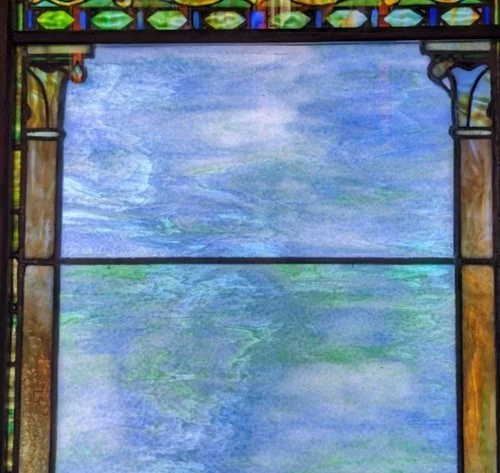Works of Art in the Lobby
St. Vincent de Paul
Medium: Marble
54 (1/4)” x 19 (7/8)” x 11 (7/8)”
St. Vincent de Paul
Statue #1
St. Vincent was born circa April 24, 1581, to a peasant farming family in the Kingdom of France. He earned a Bachelor of Theology in Toulouse and later traveled around Europe. After hearing the dying confession of a French peasant, the once selfish man had a change of heart and began charity work with wealthy Parisian women. He is the patron saint of charitable societies due to his support for hospitals, war victims, and those in poverty.
Artist: John La Farge (1835 - 1910)
Title: Venetian Banker
Date: 1883
Medium: Opalescent Glass
Style: American Art Nouveau
119 (1/2)” x 29 (1/2)”
Venetian Banker
#1
Artist: John La Farge (1835 - 1910)
Title: Christian Knight
(Man at Arms)
Date: 1883
Medium: Opalescent Glass
Style: American Art Nouveau
119 (1/4)” x 29 (1/2)”
Christian Knight
#2
Artist: John La Farge (1835 - 1910)
Title: Madonna and Child
(Mother and Child)
Date: 1883
Medium: Opalescent Glass
Style: American Art Nouveau
119 (1/4)”x 28 (1/2)”
Madonna and Child
#3
In 1883, John La Farge was commissioned by prominent members of the Brown, Ives, and Goddard families of Lonsdale, Rhode Island to manufacture three windows as a gift to the newly rebuilt Christ Church. La Farge was paid $3,000 for the three windows: a Venetian Banker, Christian Knight, and Madonna and Child. The three medieval figures are standing within a fictive architectural niche adorned with La Farge’s use of opalescent glass, giving the effect of an Old Master’s painting. The Venetian Banker portrays an older bearded man dressed in a deep red robe, analyzing the scroll before him. The Christian Knight portrays a young man wearing greaves and a breastplate, turned at a three-quarters profile at the viewer. Madonna and Child conveys a loving portrait of a young woman sitting with a child gazing fondly at his mother. All three windows have jeweled crosses featured on the lower center of the windows as well as jeweled Chi Rho symbols beneath.
Artist: Tiffany Studios (1848-1943)
Title: Marble Window
Date: ca. 1905
Medium: Opalescent & Favrile Glass
Style: American Art Nouveau
78 (1/2)” x 25 (3/4)”
Marble Window
#4
Two bronze pillars seemingly hold up this window as you gaze into a multicolored sky. This polychromatic effect was made with opalescent and favrile glass. Opalescent glass is created in glass factories to display streaks of color unique to each glass panel. Depending on the quantity of colors used in the glass, the glass replicates the kaleidoscopic qualities of opal stones. The two window panels #4 and #6 are part of the Resurrection (#81) window collection, forming a tall picture with a large colorful sky.
Artist: Tiffany Studios (1848-1943)
Title: Joan of Arc
Date: ca. 1905
Medium: Opalescent & Favrile Glass
Style: American Art Nouveau
128 (3/4)” x 40 (3/4)”
Joan of Arc
#5
Joan of Arc stands proudly with her sword in one hand and three pillars in her other hand, showing her faith in the Holy Trinity. Joan of Arc is the patron saint of France who went from a French peasant girl to a military leader during the Hundred Years' War (1337-1453) between France and England. Saints and angels counseled Joan of Arc, telling her to aid her country during the war. After winning the trust of King Charles VII's royal court, Joan donned armor and joined the battles against the English, leading them to victory.
Artist: Tiffany Studios (1848-1943)
Title: Marble Window
Date: ca. 1905
Medium: Opalescent & Favrile Glass
Style: American Art Nouveau
78 (1/2)” x 25 (3/4)”
Marble Window
#6
Just like its twin, this window is also made of opalescent and favrile glass. Louis C. Tiffany, the founder of Tiffany Studios, developed favrile glass. Opalescent glass is known as "American stained glass" and was developed by both Louis C. Tiffany and John La Farge, another painter and window maker. Despite developing the same product, Tiffany Studios, John La Farge, and the Duffner & Kimberly Company were all competitors in the glass industry during the late 19th century.
Artist: La Casa del Vitral
Title: The Ascension
Date: 2019
Medium: Stained glass
Style: American Art Nouveau
120” x 120”
The Ascension of Jesus
#7
This dome window, which was specifically constructed for the museum, depicts Jesus rising to heaven during the Ascension. The forest surrounds the entire scene with clouds swirling around Jesus, enhancing the perspective of Jesus rising above the viewer. The ascension theme is popular in Christian artwork as it is a central part of the religion to believe that he resurrected after death and united with God in heaven. The corresponding holiday is the Feast of the Ascension of Jesus Christ, celebrated on the fortieth day of Easter but varies among Christian denominations.
Religious Mosaic
Orthodox Mary & Jesus Christ
Medium: Mosaic
Orthodox Mary & Jesus Christ (Theotokos & Christ Pantocrator)
Mosaic #1
LEFT: Orthodox Mary (Theotokos)
These brilliant golden mosaics follow the Byzantine Empire mosaic style (c.395-1453). The handmade square tiles form a “gold ground” behind the figures. Theotokos is the name of the Holy Mary in the Eastern Orthodox Christian church; it is Greek for "mother of God," or "God-bearer." The "ΜΡ ΘΥ" over Mary's head is an abbreviation for her Greek title as Mother of God.
RIGHT: Jesus Christ (Christ Pantocrator)
The Christ Pantocrator image is commonly seen in Orthodox Christian art and has a longstanding tradition, with one of its earliest paintings being from around the 6th century. This mosaic is a replica of the prominent Deësis mosaic of the Hagia Sophia in Istanbul, Türkiye that dates to approximately 1261. Christ Pantocrator may be translated from Greek to "Christ Almighty." The letters surrounding the image of Christ "ICXC" are a Christogram, a monogram representing the name of Christ.
Roman Catholic Altar
Medium: Carrara Marble
151” x 115” x 46”
Depiction of St. Margaret Mary Alacoque and Jesus
St. Margaret Mary was a French nun responsible for spreading the devotion of the Sacred Heart throughout the Western Church.
Roman Catholic Altar
Altar #1
Roman Catholic Altar
Medium: Carrara Marble
151” x 115” x 46”
Depiction of St. Bernadette and Our Lady of Lourdes
Mother Mary told Bernadette that her purpose in appearing to Bernadette was to warn her to pray and make sacrifices for sinners.
Roman Catholic Altar
Altar #2
What represents a Roman Catholic altar? The five crucifixes on the altar are a representation of the five wounds of Jesus Christ and identify a Roman Catholic altar.
Altars are place for sacrifice to God:
And if you make for Me an altar of stones, do not build it of hewn stones; for by wielding your tool upon them you have profaned them.
( Exodus 20:22 )
The use of natural stones are a representation of God’s work, thus unhewn (not cut by men), as well as God’s people. Thus this practice of constructing altars out of natural stone was used for centuries and was to represent the Kingdom of God, which should be made out of stone, symbolic of God’s people.
Artist: Tiffany Studios (1848-1943)
Title: Ornamental Window
Date: 1908
Medium: Opalescent & Favrile Glass
Style: American Art Nouveau
141 (1/8)” x 31”
Ornamental Window
#8
A blossoming purple passionflower plant stands tall under two towering golden arches. In their original location, the two passionflower windows are on either side of the two Shadow of Darkness windows (museum #64). The set represents the sorrows of Good Friday, the commemoration of Jesus Christ's death and crucifixion. Despite the name of the holy day, it is a mournful day of remembrance.
Artist: Tiffany Studios (1848-1943)
Title: Ornamental Window
Date: 1906
Medium: Opalescent & Favrile Glass
Style: American Art Nouveau
141 (1/8)” x 31”
Ornamental Window
#9
The lily flower windows #9 & #10 make part of the Angels of Praise set and were originally meant to be on either side of the Angels of Praise panels (#66), in the north transept of their original church. The window set was originally named The Resurrection Window, depicting the joys of Easter.
Artist: Tiffany Studios (1848-1943)
Title: Ornamental Window
Date: 1906
Medium: Opalescent & Favrile Glass
Style: American Art Nouveau
141 (1/8)” x 31”
Ornamental Window
#10
This is the second lily flower window panel that forms the Angels of Praise set. In Western Christianity, lily flowers have several meanings, but this window set uses them as an emblem of Easter, the feast of Jesus Christ's resurrection. The Madonna lily is the main flower associated with the resurrection and is mentioned several times in the Bible, as it is a native flower to the Middle East.
Artist: Tiffany Studios (1848-1943)
Title: Ornamental Window
Date: 1908
Medium: Opalescent & Favrile Glass
Style: American Art Nouveau
141 (1/8)” x 31”
Ornamental Window
#11
This is the twin window of the #8 Shadow of Darkness: Ornamental Window and part of the Shadow of Darkness set. The passionflower is an established emblem of Jesus's death, with the legend of the flower tracing back to the early 15th century when a friar first described the flower to a monk. They concluded that the flower's three stigmas represented the nails during crucifixion, the flowers' sharp filaments represented Jesus's crown of thorns, the ten petals were the ten faithful apostles, and the leaves were St. Longinus's spear that pierced Jesus's body.













